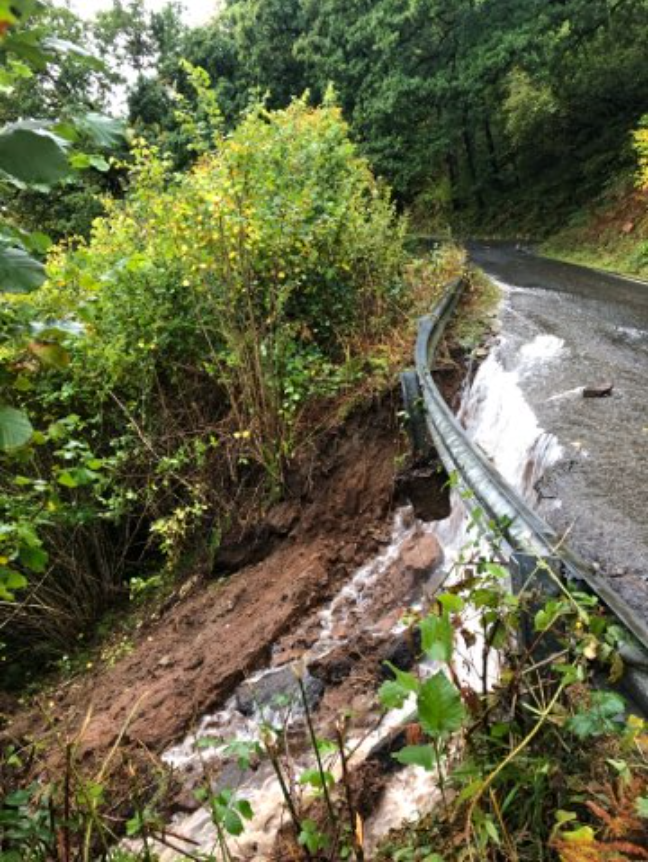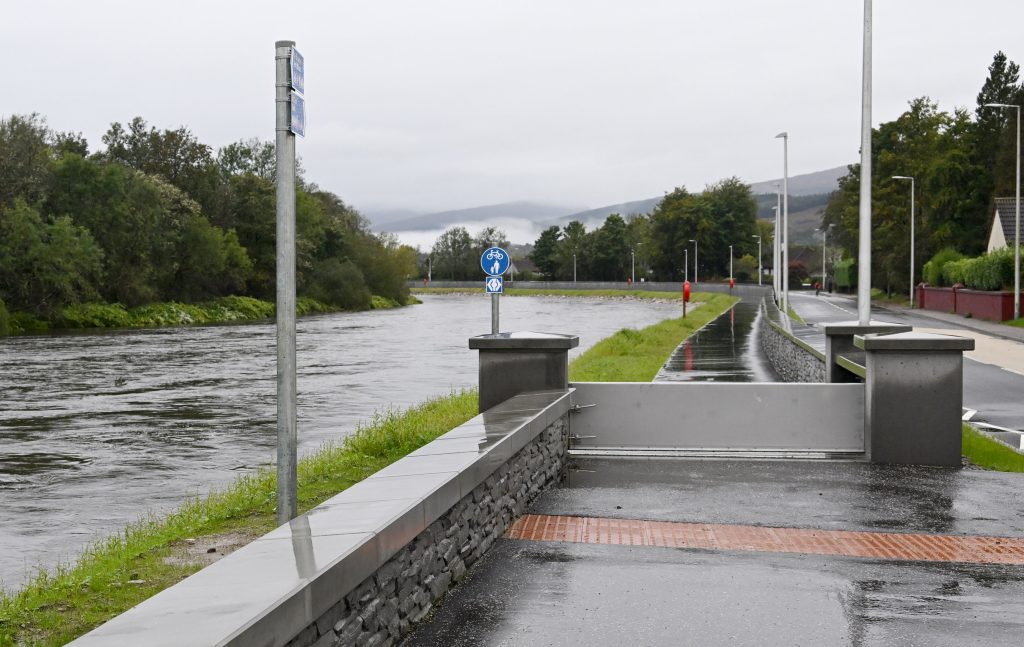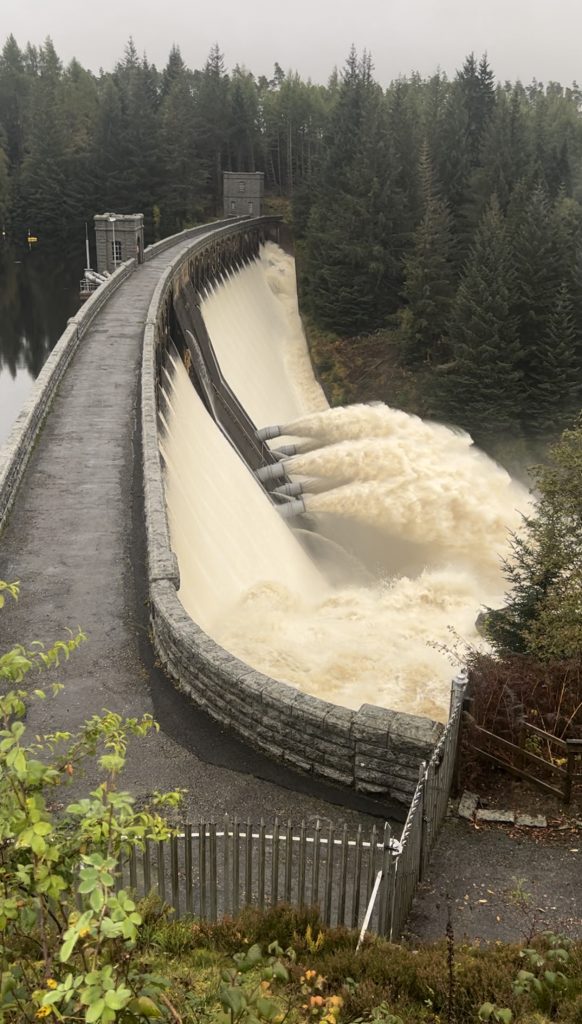Flooding and landslides have struck across Lochaber as the west of Scotland was hit by a weekend of torrential rain.
Around a fifth of the area’s average October rainfall fell in a single day as readings over 50mm were recorded in a 24 hour period at SEPA weather stations at Glen Nevis, Tobermory, and Polloch.
The downpour led to flooded streets, swelling rivers, and cancelled services.
Travel faced major disruptions.
A landslip saw the edge of the B8007 fall away at Ardslignish, forcing the sole road to Kilchoan to close on Saturday.
Although it was reopened on Sunday, the need for significant repair work means the road will be shut from 9am to 11am, 11.30 to 1.30pm, and 2pm to 4pm for the rest of the week.

The A884 from Strontian to Lochaline also closed on Saturday. Police advised motorists to use another route to reach the Morvern Peninsula, before the road reopened on Sunday.
Aftereffects of the peninsula’s rainstorms were still being felt on Tuesday, when a landslide hit on the B849 at Drimnin. The Highland Council said subsidence had resulted in the single carriageway loss of any verge or edge protection.
At the time of going to press HGV traffic was barred from the road, and an estimated three days of repair work would require limited access mirroring the times of the B8007.
On the railways, Scotrail preempted the storm by announcing on Friday that it was cancelling trains on the West Highland line on Saturday with no replacement bus service. The lines remained closed until Monday, after which the lines reopened with speed restrictions.
The exception was the Fort William to Mallaig line, which reopened on Sunday.
That reopening allowed West Coast Railways, which operates the Jacobite steam train between the two towns, to restart its service after cancelling the famous journey on Saturday by instruction of Network Rail.
The multitude of closures on the roads and railways led to reports of stranded holidaymakers and locals alike.
Two guests staying at Sanna Croft on the far west coast of the Ardnamurchan Peninsula found their holiday unexpectedly extended by a day due to the road issues Ardslignish, coupled with the continued lack of a vehicle ferry between Kilchoan and Mull.
Graham Crerar, owner of Sanna Croft, said the guests were due to leave on Sunday, but stayed on until Monday at no extra charge.
“With the single track road and the unreliable ferry, we have kind of got used to the scenario. But for the guests it was exciting to follow the stories of the rising water. It is something they can share in the wine bars of south London,” he joked.
Despite the humour, the marooned guests earned their keep: Graham himself was unable to drive back from his visit to Oban, being forced to detour via Mull for the passenger charter service. After leaving his car in Tobermory, his guests picked him up in Kilchoan.
At the time of writing he was yet to pick up his car.
In Glenfinnan, the games field was completely flooded. A small RIB was seen motoring around the usually grassy space.

Meanwhile the National Trust for Scotland (NTS) visitor centre in the village, as well as its car park and the community car park, remained closed from Saturday to Tuesday.
Emily Bryce, operations manager for NTS at Glenfinnan, said the weather and the closure of the car parks had not deterred all tourists.
“This is obviously half term so there are visitors, so I have seen people park out on the road,” she said.
“We would ask that people behave sensibly and do not park on double yellow lines or clearways through the village because that can be obstructive and hazardous. We want to be open as soon as possible.”
Councillor Angus MacDonald said he had made three trips to check out the height of the rising river Lochy in the area.
“We had been warned when building the visitor centre [The Highland Soap Company] that the river breaching its banks was once in a century event. It certainly looked likely that 2023 might be that year. In the event, luckily, we avoided a catastrophe.
“A bulk purchase of sand bags is called for I think.”
In Fort William, the newly opened £11 million Caol and Lochyside Flood Prevention Scheme was put to the test for the first time.
Opened on August 31, the weekend saw the site’s flood gates put in place. However, the Highland Council announced water did not rise above levels seen at the time the gates were closed.

The council also said it was not aware of any of its buildings requiring to shut due to flooding, but a check was being made of school properties which are currently closed for the October holidays.
A Highland Council spokesperson said: “Council staff responded with partner agencies (Police, Met Office, SEPA, NHS, SFRS, MCA, etc.) both at national and local levels on the ground and in local emergency liaison groups to coordinate responses to the incidents across the region.
“The ongoing status across Highland is still being monitored and staff are ready to respond if required.”
NHS Highland said the Highland Health and Social Care Partnership was part of the multi-agency response.
A spokesperson said: “Lochaber was identified as an area of focus and local teams ensured that all health and care provision was in place and all vulnerable people were known about and supported.
“The air ambulance and coastguard were prepared for any emergency events that could not be reached by road.”
A brighter side to the rainfall was found by visitors who braved the Laggan Dam on the A86.
With the pipes at full flow and plumes of spray in the air, the dam made for a spectacular sight.

Whilst Lochaber experienced heavy rain, it fell below that experienced in areas of Argyll. Dunstaffnage outside Oban approached 75mm in a day, and the gauge at Hazlewood Cottage recorded consecutive days of 95.2mm and 72.6mm.
Many areas experienced serious flooding and risk to life, while main roads out of Oban were closed on Saturday.
Anyone living in a flood risk community, or has been affected by flooding, can find advice and support at the Scottish Flood Forum at https://scottishfloodforum.org.